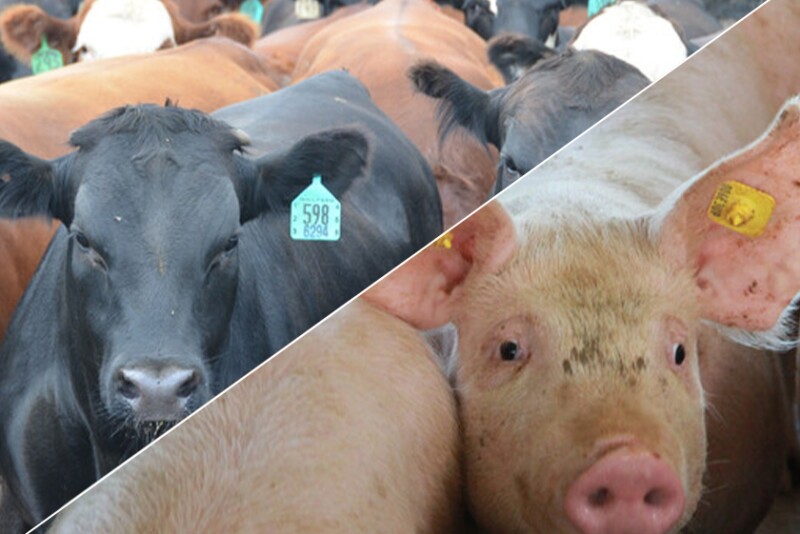Hogs
Price action: August lean hog futures closed 97.5 cents lower at $110.25, nearer session lows.
Fundamental analysis: Lean hog futures saw additional consolidation today as weakness in pork cutout has undercut futures. August futures did maintain Wednesday’s low, a key level going into the end of the week. Price action was largely driven by positioning today ahead of this afternoon’s Hogs & Pigs Report. Analysts expect USDA’s Hogs & Pigs Report this afternoon to show the U.S. hog herd contracted 0.4% from year-ago as of June 1, based on a Reuters survey. The reduction is expected to be in the market hog inventory, while the breeding herd is anticipated to be near year-ago levels. The spring pig crop is anticipated to have expanded nearly 1% from last year due to a greater number of pigs saved per litter. Details surrounding the report will be in Evening Report.
Pork cutout continues to see some consolidation following last week’s big push higher. Cutout slid $1.11 to $120.70 this morning, driven by losses in picnics, ribs and butts. Not only did prices fall, but movement slid to 99.01 loads. The consolidation in cutout has weighed on the CME lean hog index. While the index is up another 97 cents to $111.41 as of June 24, the preliminary calculation puts the index up another 48 cents to $111.89 tomorrow.
Technical analysis: August lean hog futures saw modest selling pressure today, though bulls maintain full control of the technical advantage. Support comes in at yesterday’s low of $110.13 on another push lower, while additional support stems from the 20-day moving average at $109.25. Resistance stems from the 10-day moving average at $110.90, while additional strength has bulls looking to challenge resistance at $113.00.
What to do: Get current with feed coverage.
Hedgers: You are carrying all production risk in the cash market.
Feed needs: For soymeal, you have full coverage in cash through July, with half of your needs for August, September, October, November and December covered in cash. For corn, you have all needs through August covered in the cash market, with half of your needs for September and October covered in cash.
Cattle
Price action: August live cattle rose 22 1/2 cents to $209.20, nearer the daily high after hitting a four-week low early on. August feeder cattle rose $1.00 to $303.30, nearer the session high.
Fundamental analysis: The cattle market bulls were somewhat encouraged by improved trader/investor risk appetite in the general marketplace today, and also by the still-steep discounts that live cattle futures are trading to the cash market. Cash cattle trade has been very light so far this week, averaging $230.70, according to USDA. Lower cash prices are expected once cash cattle trading develops in earnest this week. Last week’s cash cattle average price was $234.88. The noon report today showed Choice boxed beef prices fell 57 cents to $394.37, while Select gained $2.27 to $378.56. Movement at midday was 60 loads. The Choice-Select spread is presently $15.81.
USDA this morning reported U.S. beef export sales of 14,100 MT for 2025, up 20% from the previous week and up 11% from the four-week average.
Technical analysis: Live and feeder cattle futures bulls still have the overall near-term technical advantage, but have faded recently. The next upside price objective for the live cattle bulls is to close August futures above resistance at $215.00. The next downside technical objective for the bears is closing prices below solid technical support at $200.00. First resistance is seen at this week’s high of $211.90 and then at $213.00. First support is seen at today’s low of $207.70 and then at $206.00.
The next upside price objective for the feeder bulls is to close August futures prices above technical resistance at $310.00. The next downside price objective for the bears is to close prices below solid technical support at the May low of $293.05. First resistance is seen at $305.00 and then at $307.00. First support is seen at $300.00 and then at $297.50.
What to do: Get current with feed coverage. Carry all production risk in the cash market for now.
Hedgers: Carry all production risk in the cash market for now.
Feed needs: For soymeal, you have full coverage in cash through July, with half of your needs for August, September, October, November and December covered in cash. For corn, you have all needs through August covered in the cash market, with half of your needs for September and October covered in cash.

